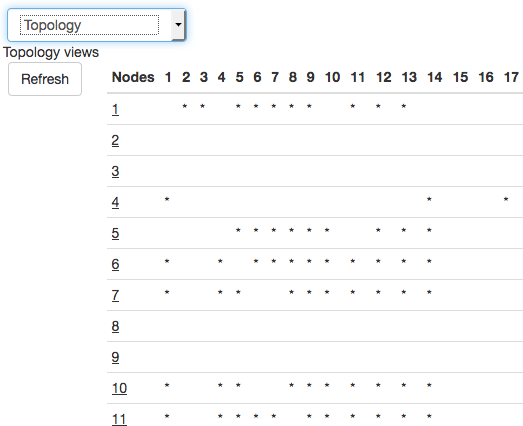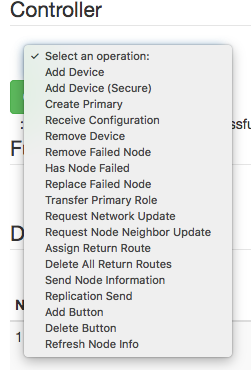Are there any of the Z-Wave diagnostic tools that are known to work with Hubitat? I have wanted to try out something like HomeSeer Z-Seer+ Z-Wave Diagnostics Software (on sale today for $29) and I read that the zwave stick int he hubitat is compatible with other software. Would really love something like this but I can't even read the text sooooo.
Has anyone used that software outside of homeseer or with a z-stick?
I have read that people have used their Z-Flash software with the zwave stick included with hubitat, but after readin about Z-Seer+ I think it needs to be a homeseer system. Not willing to pay $30 to find out it doesnt work.
I looked into this software some time ago when I purchased Z-Flash as they had a big sale on HomeSeer Pro which includes both those tools and I though maybe would be better to pay a little more and own a HomeSeer license in case I decided to migrate to it, ended just getting Z-Flash...
In any case, I think you are right, i believe that software does not directly interface with the USB stick but with HomeSeer instead
The underlying ZWave USB stick doesn't do anything more than output a table.

From that table, any "display it pretty" software will help. Clearly custom coding of a specific app is really nice.
In fact, even that is the "pretty version," the actual output from the controller looks like:
post: key=fun data=load size=4 topo: node=1 3,4,6,7,10,11,12,15,16,17,19,20,22,25,26,27,29,30,33,38,51,52,54,71,72,73,74,76,78,79,81,88,90,91,97,98,107,108,112 topo: node=4 1,18,22,34,79 topo: node=5 6,7,10,11,12,14,16,17,18,19,20,21,23,25,26,27,29,30,31,32,33,34,38,51,52,54,55,71,72,73,74,75,76,77,78,79,88,90,91,97,98,107,108,112 topo: node=6 1,5,7,10,11,12,14,15,16,17,18,19,20,21,22,23,25,26,27,29,30,31,32,33,34,38,51,52,54,55,71,72,73,74,75,78,88,90,91,97,98,107,108,112 topo: node=7 1,5,6,11,12,14,15,16,17,18,19,20,21,22,23,24,25,26,29,30,31,32,33,34,38,52,54,71,72,73,74,75,76,77,78,90,91,97,98,107,108,112 topo: node=10 1,5,6,11,12,14,15,16,17,18,19,20,21,22,23,24,25,26,27,29,30,31,33,34,38,51,52,54,55,72,73,74,75,76,77,78,90,91,97,98,107,108,112 topo: node=11 1,5,6,7,10,12,14,15,16,17,18,19,20,21,25,26,27,29,30,31,32,33,34,38,51,52,54,55,71,72,74,75,77,78,79,88,91,97,98,107,108,112 topo: node=12 1,5,6,7,10,11,14,15,16,17,18,19,20,21,22,23,24,25,26,27,29,30,31,32,33,34,38,52,54,55,71,72,73,74,76,77,78,90,91,97,107,108,112 topo: node=14 5,6,7,10,11,12,15,16,17,18,19,20,21,22,23,25,26,27,29,30,31,32,33,34,38,51,52,54,72,73,74,77,78,79,90,91,97,98,107,108,112
There is more to it than just displaying the topology, from the Z-Seer manual, these are some of the things you can do:
- Test Node - Selecting this will open a new window which gives you the option to test either the command (receiving data from HS3) or response (sending information back to HS3) capabilities of a node. You can also select the amount of packets to be tested, which are simply small amounts of data used for the sole purpose of testing connectivity. We recommend using 10 or less packets, because if a device is not communicating properly, going higher may make the test last longer than necessary.
- Full Optimize Node - This option will prompt the selected node to rediscover its neighbors, will update the master routing table and will store return routes in this device's memory.
- Set Command Route - This option will allow the user to manually set a route from the controller to this node. The chosen route will then be used by the controller unless the protocol determines a "better" route. There is no way to force the controller to use the chosen route.
- Set Return Routes - This option will allow the user to manually set return routes from this device back to the controller ("response routes"). The chosen routes will always be used for responses unless this device is is fully optimized at a later date.
I can see some of these being really useful when troubleshooting or for example when moving a device from one side of the house to another, or when a repeater is misbehaving you could manually modify the route to skip it and see if it helps, etc.
Yes, "beautifying"  the underlying commands makes them more accessible/understandable, but the underlying commands are what's in use.
the underlying commands makes them more accessible/understandable, but the underlying commands are what's in use.

I would caution you from imagining they will help with moving a device. That's managed already at the controller level. There is no ability to dictate a route.
The word "smart" in Smart Home, is a rather dumb series of commands 
Sorry, I have not gotten my HE yet, are those screenshots from HE? if that's the case then we already have this and as you said it would be all just cosmetic which although cool is not that important... If that's the case then this is great!
Man I cant wait to start playing with HE... couple more weeks until I'm able...
No, it's a different Third Party software.
I didn't realize you didn't have a Hubitat yet.
Your initial post was remarking on a Third Party software tool. The display of that data is nice in that package. But there's also other display options, especially if the raw data is available. I was pointing out that other Third Party tools provide the same raw data.
In other words, there's a bit of work to create a layout of each area of a home, and then distribute the devices across that. Perhaps there are use cases that don't involve so much labor.
Oh, I see... yes, something like what that tool shows would be a lot easier to implement yet still quite useful... May I ask what tool is that?
OZWCP (OpenZwave Control Panel)
or
Zensys Tools
A variant of OZWCP is what HASS has integrated.
Aeon distributes their OTA code using Zensys.
And those tools work with Hubitat? Thats basically what i'm asking is if there are anything like those.
hmmm... don't know how to answer... because the answer is so much more complicated when you don't already know Hubitat.
Hubitat has no integration with the tools. They are stand alone, off to the side, style tools. There may be only 6 of us in this community using them.. another dozen that tried them and decided it wasn't useful, mostly because they are so low level. 
To add them, to get them working, you need a ZWave USB stick. I would recommend getting one for this purpose, probably the Aeon ZStick Gen5 because it's so useful after you turn off the Third Party tools.
A "raw" fresh out of the box ZStick is like any other ZWave device. It needs to join a network. Yes, it will join Hubitat as a Secondary Controller... which sounds wonderful except it uses "secondary" in a meaning that has nothing to do with what most humans would think. During the join/pair, the list of devices known to the Hubitat ZWave Radio stick will be passed to the secondary.
You then have to get the Third Party software installed and running on some other computer... RasberryPI for example for OZWCP or Windows for Zensys tools. Personally I have virtual computers for this.. Debian for OZWCP and Win7 for Zensys.
All that for 10 low level commands that you must string together to get anything done. It's useful if you need that, nothing else will do, BUT it's a lot of time investment for most people.
People in the Hubitat community have used these tools to solve specific problems.. for instance, if you get a "ghost" device on your Hubitat ZWave radio stick, these tools may be the last resort for clearing it.
"Ghost" in the sense that the device was once paired (the ZWave radio stick knows about it) but it was deleted from the Hub. This can occur when you "discard" a device without properly Excluding it first. Often we assume we will get back around to using it, but it sits in a drawer for months.. in the mean time, it was cluttering up the Hub's UI and you force deleted it.
For completeness, I will say you CAN unplug the ZWave Radio stick from Hubitat (after a proper shutdown) and use it with the Third Party tools, thus saving you the work of joining. But quite obviously, your Hub and all of it's automation is down the entire time. This method is needed to remove "ghosts" from the Hubitat stick.
I think what most people really want is something to help determine performance of the zwave network as a whole. If there is a repeater that's not doing it's job or delaying packets...it would be nice to identify it...without just unhooking 1 at a time where there is an issue, and then really just guessing what the issue was.
The "Test Node" above in @gparra's post seems like a very useful tool. It would be nice if there was a stand alone zwave tool kit that was easy to use. I've played with the zensys tools and they are not intuitive. I was able to see the map as above which "kind of" helped. I found some methods for testing but couldn't discern the output.
Oh and don't waste your time with the HomeSeer Zwave Diagnostics tools unless you have a homeseer system....
Or even better, it would be great if Hubitat could eventually add some of this functionality to the Admin site... of course I'm sure their roadmap / backlog is quite big so...
What about this device for z-wave troubleshooting/ diagnostics? It is expensive though. I am not sure I really understand though if this is standalone or works with a hub? Is anyone familiar with it?
After Joining it to your ZWave network, it has it's own interface as I understand it. I don't have one, but I have hovered over the Buy button more than once.
I have one, you must pair it to your mesh to troubleshoot the mesh, it works, I discovered ghost nodes, devices recently added with 1 route, battery devices repeating(ct101) and some slow devices. But after you spent the money on it, do you really have a use for it? I almost don't use it, maybe in a month when my friend starts a new home automation.
Does it offer any tools to fix the detected problems? If not, how do you fix those identified problems?

